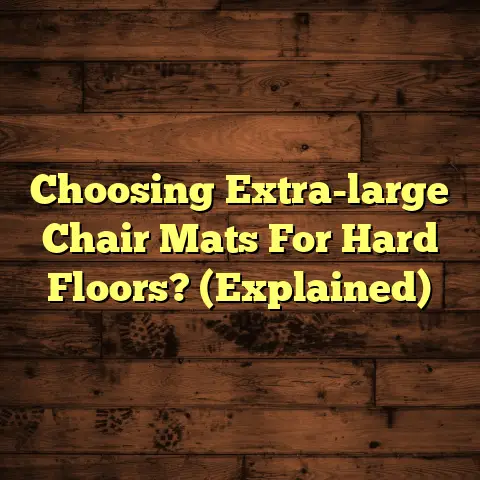Squeaky Floors? (6 Fast Fixes, Before Demo!)
Ever been chilling at home, maybe with a good book or binge-watching your favorite show, and BAM!
Squeak! Squeak!
It’s like your floor is staging a protest. I get it. It’s annoying.
More than annoying, actually. It can be downright frustrating, especially when you have guests over or you’re trying to enjoy some peace and quiet.
I’ve seen homeowners driven to the brink by these pesky noises, even considering ripping up the entire floor! But hold on a second.
Before you grab that sledgehammer, let’s talk about some fast, effective fixes that might just save you a whole lot of time, money, and sanity.
As a flooring contractor with years under my belt, I’ve tackled countless squeaky floor situations.
And I’m here to tell you, most of the time, the solution is simpler than you think.
Section 1: Understanding the Cause of Squeaky Floors
Okay, so why do floors squeak in the first place? It’s not just some random act of house rebellion.
There’s usually a pretty straightforward reason. Most often, it boils down to friction.
Think of it like this: your floorboards, subfloor, and joists are all supposed to be snug and happy together. But over time, things can loosen up.
Nails can start to pull out, wood can dry out and shrink, and things that were once tight become, well, not so tight.
When you walk across the floor, these loose elements rub against each other, creating that telltale squeak.
Here’s a quick breakdown of common culprits:
-
Loose Floorboards: This is a big one. When boards aren’t properly secured to the subfloor, they can move and rub, causing squeaks.
-
Nails Rubbing: Old nails can loosen and rub against the wood around them. It’s like a tiny metal-on-wood symphony of annoyance.
-
Expansion and Contraction: Wood is a natural material, and it expands and contracts with changes in temperature and humidity. This movement can cause friction and, you guessed it, squeaks.
-
Subfloor Issues: Sometimes, the subfloor itself is the problem. If it’s not properly secured to the joists, it can move and squeak.
-
Joist Problems: Joists are the support beams underneath your floor. If they’re sagging or loose, they can cause the floor above to squeak.
Different types of flooring can also contribute to the problem. For example, hardwood floors are more prone to squeaking than some types of vinyl flooring because they’re made of natural wood that expands and contracts.
Laminate floors can also squeak if they’re not properly installed or if the subfloor is uneven.
Recognizing the Squeak:
Not all squeaks are created equal. Pay attention to when and where the squeak occurs.
-
Walking Squeaks: These are the most common. They happen when you step on a specific spot on the floor.
-
Settling Squeaks: These might occur when the house settles, often after changes in weather or humidity.
-
Structural Squeaks: These are more serious and might indicate a problem with the foundation or joists. If you suspect this, it’s best to call a professional.
Identifying the root cause is crucial. Don’t just start throwing talcum powder everywhere!
Take some time to investigate the squeak. Press down on the floor around the squeaky spot.
Can you feel any movement? Is the squeak louder in one area than another?
This will help you narrow down the problem and choose the right solution.
Section 2: Quick Fix #1 – The Talcum Powder Technique
Okay, let’s start with the easiest fix of all: talcum powder.
Yes, the same stuff you might use on a baby’s bottom can actually silence a squeaky floor!
Here’s how it works:
Talcum powder acts as a dry lubricant. It fills in the small gaps between floorboards, reducing friction and stopping the squeak.
It’s best for minor squeaks caused by slight movement between boards.
Step-by-Step Guide:
-
Locate the Squeak: Walk around the area and pinpoint the exact spot where the squeak is coming from.
-
Sprinkle the Powder: Generously sprinkle talcum powder over the squeaky area, focusing on the cracks between the floorboards.
-
Work It In: Use a soft brush or your fingers to work the powder into the cracks. You want to make sure it gets down into the gaps.
-
Clean Up: Wipe away any excess powder with a damp cloth.
-
Test It Out: Walk across the area again to see if the squeak is gone. If not, repeat the process.
Tips for Success:
-
Use a Powder Puffer: A powder puffer or squeeze bottle can help you get the powder into hard-to-reach cracks.
-
Be Patient: It might take a few applications to completely eliminate the squeak.
-
Consider Alternatives: If you don’t have talcum powder, you can also use powdered graphite or baking soda.
Anecdote Time:
I once had a client who was ready to tear up her entire living room floor because of a persistent squeak. I suggested trying the talcum powder trick first, and she was skeptical, to say the least.
But after a few applications, the squeak was gone! She was so relieved and grateful that she didn’t have to go through with a major renovation.
How Long Will It Last?
The talcum powder fix is usually a temporary solution. It might last for a few weeks or months, depending on how much movement there is in the floor.
You might need to reapply it periodically to keep the squeak at bay.
Section 3: Quick Fix #2 – The Wood Glue Solution
Alright, let’s move on to a slightly more involved fix: wood glue.
This is a great option for loose floorboards that are causing a squeak.
How It Works:
Wood glue is a strong adhesive that bonds wood together. By applying it to the underside of a loose floorboard, you can secure it to the subfloor and eliminate the movement that’s causing the squeak.
Step-by-Step Guide:
-
Identify the Loose Board: Find the squeaky spot and determine which board is loose. You might be able to feel it move slightly when you step on it.
-
Access the Underside: This is where it gets a little tricky. You’ll need to access the underside of the floor. This might involve going into a basement or crawl space.
-
Clean the Area: Use a brush or vacuum to clean the area around the loose board and the subfloor. You want to make sure the glue has a clean surface to adhere to.
-
Apply the Glue: Apply a generous amount of wood glue to the underside of the loose board and the surrounding subfloor.
-
Clamp It Down: Use clamps to hold the board firmly in place while the glue dries. This will ensure a strong bond.
-
Let It Dry: Allow the glue to dry completely according to the manufacturer’s instructions. This usually takes at least 24 hours.
-
Remove the Clamps: Once the glue is dry, remove the clamps and test the floor to see if the squeak is gone.
Tips for Success:
-
Use the Right Glue: Make sure you’re using a high-quality wood glue that’s designed for flooring.
-
Don’t Overdo It: Applying too much glue can actually weaken the bond. Use just enough to coat the surfaces.
-
Protect the Floor: Place a piece of wood or cardboard between the clamps and the floor to prevent damage.
Potential Pitfalls:
-
Inaccessibility: Sometimes, it’s just not possible to access the underside of the floor. In that case, you’ll need to consider other options.
-
Existing Damage: If the floorboard is already damaged or warped, glue might not be enough to fix the problem.
When Is This Method Insufficient?
If the squeak is caused by a larger structural problem, like sagging joists, wood glue won’t solve the issue. You’ll need to address the underlying problem first.
Section 4: Quick Fix #3 – The Screw Method
Now, let’s talk about a more permanent solution: screws.
Using screws to secure loose floorboards is a great way to eliminate squeaks and keep your floor solid.
How It Works:
Screws provide a strong, reliable connection between the floorboards and the subfloor. They’re less likely to loosen over time than nails, making this a more long-lasting fix.
Step-by-Step Guide:
-
Choose the Right Screws: Select screws that are long enough to penetrate the floorboard and the subfloor, but not so long that they go all the way through. I usually recommend 1 1/4″ to 1 5/8″ screws.
-
Drill Pilot Holes: This is crucial! Drilling pilot holes prevents the wood from splitting and makes it easier to drive the screws in straight. Use a drill bit that’s slightly smaller than the diameter of the screws.
-
Countersink the Screws: Use a countersinking drill bit to create a small recess for the screw heads. This will allow the screw heads to sit flush with the surface of the floor, preventing tripping hazards.
-
Drive in the Screws: Use a screwdriver or drill to drive the screws into the pilot holes. Be careful not to overtighten them, as this can strip the threads.
-
Conceal the Screws (Optional): If you want to hide the screw heads, you can fill the countersunk holes with wood filler that matches the color of your floor. Once the filler is dry, sand it smooth.
Tips for Success:
-
Use Deck Screws: Deck screws are designed for outdoor use, so they’re resistant to corrosion and moisture. This makes them a good choice for flooring.
-
Stagger the Screws: Don’t put all the screws in a straight line. Staggering them will provide a stronger hold.
-
Test the Floor: After you’ve installed the screws, walk across the area to see if the squeak is gone. If not, add more screws as needed.
Blending the Screws:
If you don’t want to fill the screw holes with wood filler, you can try to blend the screws with the existing floor by using screws that are the same color as the wood.
You can also use screw head covers that snap over the screw heads and match the floor.
Section 5: Quick Fix #4 – The Shim Technique
Let’s move onto shims, another handy tool in the squeaky floor-fighting arsenal.
How It Works:
Shims are thin, tapered pieces of wood that can be inserted into gaps between the joists and the subfloor. They provide support and prevent movement, eliminating squeaks.
Step-by-Step Guide:
-
Locate the Gap: This can be tricky. You’ll need to access the underside of the floor and look for gaps between the joists and the subfloor. A flashlight can be helpful.
-
Choose the Right Shims: You can buy wooden shims at most hardware stores. Choose shims that are the right thickness to fill the gap.
-
Insert the Shim: Carefully insert the shim into the gap. You might need to use a hammer to gently tap it into place. Be careful not to damage the floor.
-
Test the Floor: Walk across the floor above to see if the squeak is gone. If not, add more shims as needed.
-
Secure the Shim (Optional): Once you’ve eliminated the squeak, you can secure the shim in place with wood glue or screws.
Best Materials to Use:
-
Wood Shims: These are the most common type of shim. They’re inexpensive and easy to work with.
-
Plastic Shims: These are more durable than wood shims and won’t rot or decay.
-
Composite Shims: These are made from a combination of wood and plastic. They’re strong and resistant to moisture.
Inserting Shims Without Damage:
The key is to be gentle. Don’t try to force the shim into the gap. Use a hammer to gently tap it into place.
If you’re having trouble inserting the shim, try sanding it down a bit to make it thinner.
Long-Term Benefits:
In addition to eliminating squeaks, shims can also help to prevent future problems by providing extra support to the floor.
Section 6: Quick Fix #5 – The Squeak Ender Kit
Okay, let’s talk about a product specifically designed to tackle squeaky floors: the Squeak Ender Kit.
What Is a Squeak Ender Kit?
A Squeak Ender Kit is a system that uses specially designed screws to pull the subfloor tight against the floor joists, eliminating the gap that causes squeaks.
How It Works:
The kit includes screws, a driver bit, and a depth-control attachment.
The depth-control attachment ensures that the screws are driven to the correct depth, preventing them from going all the way through the floor.
Step-by-Step Guide:
-
Locate the Squeak: Find the squeaky spot on the floor.
-
Insert the Screw: Place the screw on the spot where you want to eliminate the squeak.
-
Drive in the Screw: Use the driver bit and depth-control attachment to drive the screw into the floor.
-
Snap Off the Head: Once the screw is driven to the correct depth, the head will automatically snap off, leaving a clean, flush finish.
Pros and Cons:
Pros:
- Easy to use
- Effective at eliminating squeaks
- Leaves a clean, flush finish
Cons:
- Can be more expensive than other fixes
- Might not work on all types of floors
Testimonials:
I’ve had clients rave about Squeak Ender Kits. They’re especially popular for hardwood floors, where you want to avoid visible screw heads.
One client told me, “I was amazed at how easy it was to use. I had a squeaky spot in my hallway that was driving me crazy, and the Squeak Ender Kit fixed it in minutes!”
Section 7: Quick Fix #6 – The Professional Evaluation
Alright, we’ve covered a lot of DIY fixes. But sometimes, you just need to call in the pros.
When to Call an Expert:
-
Structural Issues: If you suspect that the squeak is caused by a structural problem, like sagging joists or a foundation issue, it’s best to call a professional.
-
Extensive Damage: If the floor is extensively damaged or warped, it might be beyond the scope of a DIY fix.
-
Uncertainty: If you’re not sure what’s causing the squeak or how to fix it, it’s always a good idea to get a professional opinion.
What to Expect from a Professional:
A professional flooring contractor will be able to quickly identify the cause of the squeak and recommend the best solution.
They’ll also have the tools and expertise to fix the problem quickly and efficiently.
In some cases, they might recommend replacing the entire floor. But in most cases, they’ll be able to find a less expensive and less disruptive solution.
Addressing Underlying Issues:
It’s important to remember that squeaky floors can sometimes be a symptom of a larger problem.
A professional will be able to identify any underlying issues and recommend the appropriate course of action.
Conclusion:
Squeaky floors are annoying, but they don’t always mean you need a complete flooring overhaul.
With a little detective work and the right tools, you can often fix the problem yourself.
So, before you start ripping up your floors, try one of these quick fixes. You might be surprised at how easy it is to silence those pesky squeaks and restore peace and quiet to your home.
Call to Action:
Have you ever dealt with squeaky floors? What quick fix worked best for you?
Share your experiences in the comments below! And if you have any questions, don’t hesitate to ask.
Remember, your home should be a sanctuary, free from disruptive noises. Let’s work together to make that a reality!





